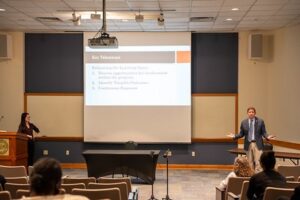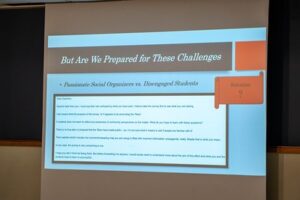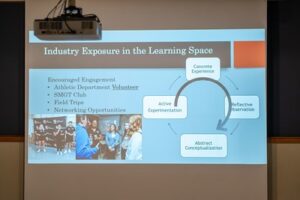Colleen Grahek
Contributing Writer
How does “one plus one equal three”? What is the meaning of the title of the second provost colloquium?
Assistant professors of sports management, Edward J. Arner and Xiaochen Zhou, hosted the latest provost colloquium last Wednesday night in Beers Lecture Hall. They discussed the different factors of professional exposure in the learning environment, how the personal experiences of the educator can affect their teachings in the classroom and what professors can do to help connect students in ways that are helpful to the their academic needs.

“Experiences are created through individual students and attributes of the environment,” Arner said. “Each of us brings something to that learning environment that is unique.”
Arner explained that Zhou approached him with the idea of conducting the colloquium and added that the significance of the “One Plus One Equals Three” title is about how the teaching, service and research come together to help educators shape a more effective learning environment.
The title also symbolizes how Arner and Zhou have come together to bring their own unique research backgrounds to enhance the learning space both inside and outside the classroom.
The first half of the colloquium focused on Zhou’s background and how it connected to her mission as an educator. With over 20 years of global, sport marketing and business research, she also highlighted how her heritage and background of being born and raised in China has influenced her teachings.

Zhou talked about her real-life experience of conducting a survey with the Chinatown, Philadelphia community. The survey was about a proposal for a new Philadelphia 76ers arena that was to be built in the Chinatown area. The proposal included a plan to demolish homes and businesses to create space for the new arena. She explained her personal involvement not only with the surveys but also with the 2023 Save Chinatown Coalition.
She stated that active participation is key to effective research and establishing trust in the community the student is researching.
“I utilize my research, service and community connections and I bring them to the students,” Zhou said.
Zhou then talked about the challenges that may be presented in classroom research overall. This includes the following:
- Disengaged students: Zhou notes that the term “disengaged” is the proper term of use. How can professors help students connect to what they are learning about when they don’t even care? If the student does not have prior knowledge or connection to the subject, how can the educators make the information more relatable in a way the student can understand?
- Misalignment between students and the service or community: If the purpose of the study or project does not align with the position of the community organization the students are studying, or if the students do not understand the purpose of their research, it can create a disconnect between the students and their subjects.

Arner transitioned into the second half of the colloquium by adding that a student’s disconnection with the subject matter can also disconnect the student from the educator. He added that the teaching and service aspects of educators helping students find their passion in their field is an ongoing process.
Arner stated that his passion for athletics and sports management helped him discover his love for teaching. After over 25 years of working in the sports industry, he brought that passion and experience into the classroom. The prior experience helps enhance his teaching.
In order to allow students to be able to experience that same drive for passion for what they are learning in their field, Arner explained that early encouragement of engagement and experimentation within their department and academic community is a major factor. This may include volunteering at college events, field trips and finding ways to network and gain that professional experience.
“It’s not just about getting involved in academic events. It’s about being involved and engaged in the academic community,” Arner said. “It can be about anything. Mostly, it’s about encouraging students to go out and get what they want and applying what they’re learning.”

When asked by a student attendee about how this study and process affects transfer students who may not have the same amount of time or opportunities for engagement as a four-year student, Arner said the community is working to factor in on how he can ensure that all students gain the same number of opportunities.
“We have seen that a lot of our transfer students come from Northampton Community College, which is an important target for us as far as a good relationship,” Arner said. “Because at a community college, exposure to the industry is a lot different. We do want to make sure we address that there is enough opportunity here for everyone.”
To view the recording of this colloquium please visit either of these links:

